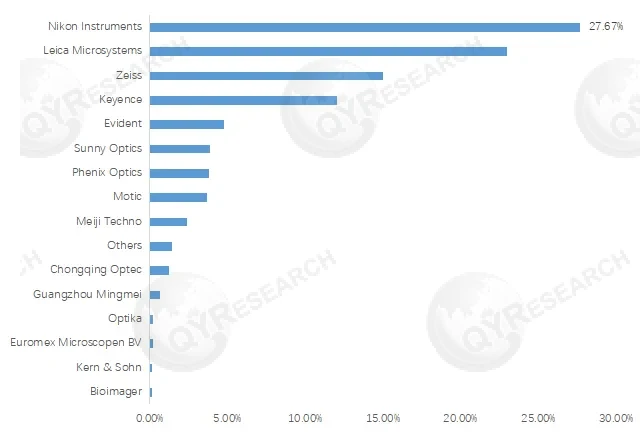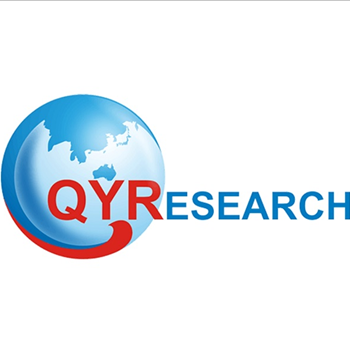Right Now
Inverted Fluorescence Microscope Market Trends:the market size is projected to grow from USD 319.46 million in 2024 to USD 504.95 million by 2031
An inverted fluorescence microscope is a specially designed microscopic imaging device with an optical system in an "inverted" configuration-the light source and objective are below the stage, and the eyepiece or camera is above. The essence of "fluorescence" is the visible light of a specific wavelength released after the label is excited. This design allows direct observation of living samples (e.g. cells, tissues) in culture dishes, culture flasks, etc., especially for dynamic biological studies.
According to the new market research report Inverted Fluorescence Microscope - Global Market Share and Ranking, Overall Sales and Demand Forecast 2025-2031", published by QYResearch, the global Inverted Fluorescence Microscope market size is projected to grow from USD 319.46 million in 2024 to USD 504.95 million by 2031, at a CAGR of 6.54% during the forecast period.
Figure00001. Global Inverted Fluorescence Microscope Market Size (US$ Million), 2020-2031
Source: QYResearch, "Inverted Fluorescence Microscope - Global Market Share and Ranking, Overall Sales and Demand Forecast 2025-2031”
Figure00002. Global Inverted Fluorescence Microscope Top 15 Players Ranking and Market Share (Ranking is based on the revenue of 2025, continually updated)

Source: QYResearch, "Inverted Fluorescence Microscope - Global Market Share and Ranking, Overall Sales and Demand Forecast 2025-2031”
This report profiles key players of Inverted Fluorescence Microscope such as Nikon, Leica and Zeiss.
In 2025, the global top five Inverted Fluorescence Microscope players account for 82.39% of market share in terms of revenue. Above figure shows the key players ranked by revenue in Inverted Fluorescence Microscope.
In terms of product type, type one is the largest segment, hold a share of 77%.
In terms of product application, application one is the largest application, hold a share of 44.09%,
Main Drivers:
The global inverted fluorescence microscope market is growing steadily, reaching $319 million in 2024 and projected to reach $505 million in 2031, representing a compound annual growth rate (CAGR) of 6.54% (2025-2031). At the regional level, the China market has changed rapidly in the past few years. In 2024, the market size will be USD 63.75 million, accounting for about 20.0% of the global market. It is estimated that it will reach USD 101.5 million in 2031, when the global market share will reach 19.92%. The growth in demand is mainly due to the explosion in life sciences (e.g. gene editing, single-cell analysis), upgrading of industrial testing (semiconductor, nanomaterials research demand) and popularization of education (STEM education promotion).
Intelligent and AI fusion: Most devices have achieved autofocus and image recognition (such as AI cancer cell classification), significantly improving scientific research efficiency and data accuracy.
High-resolution and multi-modal integration: super-resolution imaging (such as two-photon laser scanning) and multi-spectral technology integration promote breakthrough in imaging quality and improve the accuracy of tumor diagnosis.
Domestic technology breakthrough: local enterprises (Sunny Optics) through self-developed optical systems, low-noise sensors, etc., the localization rate has been greatly improved, cost-effective advantages accelerate import substitution.
Main Obstacles:
Technology iteration acceleration is the primary challenge in the industry. International giants (such as Zeiss and Nikon Instruments) continue to raise the industry threshold through super-resolution imaging and AI fusion technology, while domestic enterprises lack self-sufficiency in the field of high-end optical elements (objective lens and detector), and the core components still rely on German and Japanese enterprises. At the same time, the uncertainty of technical route increases, for example, multi-modal integration (fluorescence + confocal + structured light) has a long R & D cycle and high investment. If it fails to accurately match the scientific research demand, it will lead to mismatch of R & D resources and lag of market acceptance.
The global market is facing structural differentiation: international brands monopolize the high-end market and build barriers through technical patents; domestic enterprises are concentrated in the middle and low-end fields, product homogenization causes price war, and gross profit margin continues to decline. Localized production policies in emerging markets (such as Southeast Asia) further divert orders, while trade protection measures in North America and the European Union raise the cost of going to sea and squeeze the profit margins of domestic enterprises.
Industry Development Opportunities:
China's policies are tilted: the Ministry of Science and Technology has set up a special fund of 5 billion yuan to support the research and development of high-end equipment; the "14th Five-Year Plan" clarifies domestic substitution goals, the proportion of medical institutions purchasing domestic equipment increases, and tax incentives reduce corporate costs.
International scientific research investment: EU "Horizon Europe" program, special funding from the National Cancer Institute of the United States to promote technology upgrading, North American life science R & D investment accounts for a high proportion, directly driving the demand for high-end equipment.
Biomedical core position consolidated: live cell imaging, pathological diagnosis (such as cancer early screening) position is stable, immunotherapy monitoring demand surge to promote high-precision equipment procurement.
Emerging fields: materials science (nanostructure analysis), environmental monitoring (microbial detection), pharmaceutical industry (high-throughput drug screening) as new growth points.
Portable and scenario adaptation: Miniaturized equipment meets the needs of mobile laboratories after the epidemic, such as field research and field detection scenarios, resulting in portable model innovation.
About QYResearch
QYResearch founded in California, USA in 2007.It is a leading global market research and consulting company. With over 17 years’ experience and professional research team in various cities over the world QY Research focuses on management consulting, database and seminar services, IPO consulting (data is widely cited in prospectuses, annual reports and presentations), industry chain research and customized research to help our clients in providing non-linear revenue model and make them successful. We are globally recognized for our expansive portfolio of services, good corporate citizenship, and our strong commitment to sustainability. Up to now, we have cooperated with more than 60,000 clients across five continents. Let’s work closely with you and build a bold and better future.
QYResearch is a world-renowned large-scale consulting company. The industry covers various high-tech industry chain market segments, spanning the semiconductor industry chain (semiconductor equipment and parts, semiconductor materials, ICs, Foundry, packaging and testing, discrete devices, sensors, optoelectronic devices), photovoltaic industry chain (equipment, cells, modules, auxiliary material brackets, inverters, power station terminals), new energy automobile industry chain (batteries and materials, auto parts, batteries, motors, electronic control, automotive semiconductors, etc.), communication industry chain (communication system equipment, terminal equipment, electronic components, RF front-end, optical modules, 4G/5G/6G, broadband, IoT, digital economy, AI), advanced materials industry Chain (metal materials, polymer materials, ceramic materials, nano materials, etc.), machinery manufacturing industry chain (CNC machine tools, construction machinery, electrical machinery, 3C automation, industrial robots, lasers, industrial control, drones), food, beverages and pharmaceuticals, medical equipment, agriculture, etc.
Contact Us:
If you have any queries regarding this report or if you would like further information, please contact us:
QY Research Inc.
Add: 17890 Castleton Street Suite 369 City of Industry CA 91748 United States
E-mail: global@qyresearch.com
Tel: 001-626-842-1666(US) 0086-133 1872 9947(CN)
More Posts



















Report This Post
Please complete the following requested information to flag this post and report abuse, or offensive content. Your report will be reviewed within 24 hours. We will take appropriate action as described in Findit terms of use.


